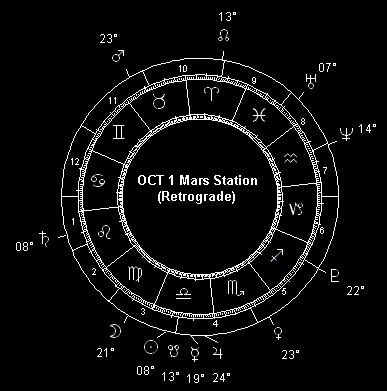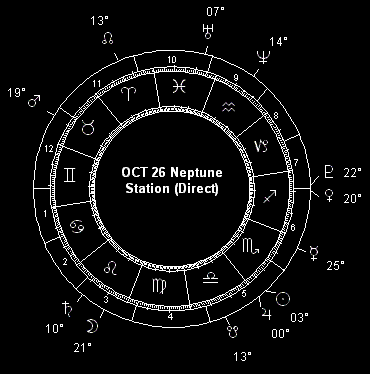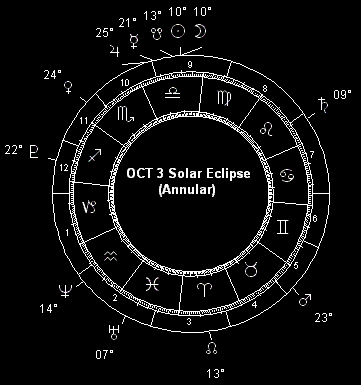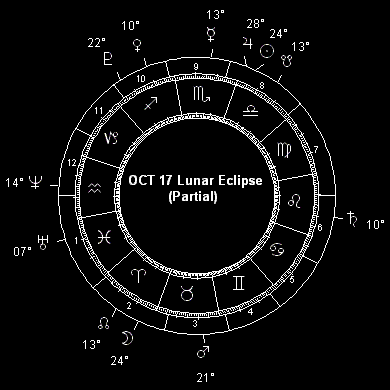If you were expecting some kind of sun sign nonsense, forget it. This is real astrology. See the section above. And if you need help deciphering the astrological glyphs in the graphics accompanying this article, see Astroglyphs: Astrological Symbols Guide. Please note: this forecast is expressed in terms of Universal Time (UT).
The past, present, and future mingle and pull us . . . we are made up of layers, cells, constellations.
-- Anais Nin
 With its pair of eclipses, October shapes up to be the last of the really turbulent months for a while; at least as far as natural upheavals like monster storms, earthquakes, volcanic eruptions and such are concerned. Human turbulence, on the other hand, is just starting to crank up the volume; what with the Red Planet kicking off its ten-week retrograde on the 1st and drawing nearer to our home planet with each passing day this month. And coming events cast their shadow before later on this month, as Jupiter enters Scorpio and Neptune stations in Aquarius: the last component of the Saturn-Jupiter-Neptune T-square in Leo-Scorpio-Aquarius is now sliding into place. For the first time in 1,500 years, the configuration not seen since the days of "the last Roman Emperor" (Justinian) is once more lining up in the heavens.
With its pair of eclipses, October shapes up to be the last of the really turbulent months for a while; at least as far as natural upheavals like monster storms, earthquakes, volcanic eruptions and such are concerned. Human turbulence, on the other hand, is just starting to crank up the volume; what with the Red Planet kicking off its ten-week retrograde on the 1st and drawing nearer to our home planet with each passing day this month. And coming events cast their shadow before later on this month, as Jupiter enters Scorpio and Neptune stations in Aquarius: the last component of the Saturn-Jupiter-Neptune T-square in Leo-Scorpio-Aquarius is now sliding into place. For the first time in 1,500 years, the configuration not seen since the days of "the last Roman Emperor" (Justinian) is once more lining up in the heavens.
October starts off with a bang - literally - what with Mars turning retrograde on the 1st. As I've already indicated, this sets up "the most significant and sustained Red Planet activation of the year - in a couple years, in fact. It lasts into 2006, and it signals a period of risk, danger and conflict." Mars has been within a few degrees of its October 1 station point since September 10, so this is a trend that's already in progress as October begins. From collective violence like war to individual violence like murder and other criminality (and including that strange twilight, terrorism), and even including accidents and crashes and fires and explosions due to recklessness or evil intent and sometimes just plain bad luck (e.g. a lightning strike), the whole of October is a time to keep your eyes open, your head down and your guard up.
The last couple months have witnessed several similar (though lesser) Red Planet activations, which have played out as predicted; coinciding with the July 7 London mass transit bombings and the terror attacks at Sharm el-Sheikh, Egypt on July 23, as well as the August 9 chemical plant explosions in Michigan. The sad truth is that things get worse in this regard, before they get better. September, with its Iraqi battles and car bombs and mass murders, its California fires and many scattered train, plane and bus crashes, was just the warm-up for the most prominent Mars phase since the 2003 Mars super perigee; and it just gets stronger this month. The cycle peaks in early November as the Sun opposes Mars while the Red Planet squares Saturn.
I'm not going Chicken Little on you, this isn't a doomsday cycle. But it does point to a time when human passions are inflamed and dangerous mishaps abound. There's a surfeit of recklessness, haste, impudence and belligerence; courage too, and sometimes that just makes things worse. Stay alert, avoid places (and people) associated with trouble as much as possible - and where that's not possible, then be ready. Fires, crashes, explosions and accidents are more than usually plentiful when Mars looms large like this. Watch the news, watch out for the other guy, watch where you're going and what you're doing (particularly when tools, machinery or weapons are involved) - you'll see what I mean.
 The Red Planet isn't the only major player in the October skies, even though it's head and shoulders above the rest. Outer planet stations are another celestial theme in effect throughout the month. Pluto's September 2 direct station is a case in point. It began on September 2, when Pluto ended the period of apparent reverse motion that it began back on March 26. Coming to an apparent standstill at 21° 49' Sagittarius on September 2 and then resuming its normal direction of travel through our skies, Pluto spent all of last month within a degree its station point - just as it spent the entire month of August. Likewise, the whole of October, and in fact right up until November 3. In combination with the lunar declination extreme occurring this month (and again in the spring of 2006), this particular Pluto station looks like the herald of some major profit taking in the financial markets. The major market indices continue to look awfully shaky this month, even as many commodities look strong - especially within a few days of the 7th and 10th early in the month, and within a few days of the 21st and 24th later in the month.
The Red Planet isn't the only major player in the October skies, even though it's head and shoulders above the rest. Outer planet stations are another celestial theme in effect throughout the month. Pluto's September 2 direct station is a case in point. It began on September 2, when Pluto ended the period of apparent reverse motion that it began back on March 26. Coming to an apparent standstill at 21° 49' Sagittarius on September 2 and then resuming its normal direction of travel through our skies, Pluto spent all of last month within a degree its station point - just as it spent the entire month of August. Likewise, the whole of October, and in fact right up until November 3. In combination with the lunar declination extreme occurring this month (and again in the spring of 2006), this particular Pluto station looks like the herald of some major profit taking in the financial markets. The major market indices continue to look awfully shaky this month, even as many commodities look strong - especially within a few days of the 7th and 10th early in the month, and within a few days of the 21st and 24th later in the month.
Neptune also remains within a degree of its October 26 direct station at 14° 49' Aquarius throughout the month, and on into mid-December. Likewise, Saturn and Uranus both station in November, and each is within a degree of its station point for at least part of October: the whole month, in the case of Uranus; and from the 20th onward, in the case of Saturn. There's a whole lot going on here, and in combination with other factors - including the eclipses and declination extremes - the total picture includes a risk of a breakdown in major stock markets, further disruption in energy supplies, and notable outbreaks of disease this month and this fall as a whole. On the plus side, the emergence or production of new medicines and medical techniques during this period can help address public health issues. However political paralysis and breakdown has a long way to go yet. Business as usual is the only sure formula for catastrophe at critical junctures like this, and the power brokers just don't get it yet.
The disaster that was Hurricane Katrina is a tragic illustration of a secular lunar declination cycle, which as mentioned in my 2005 World Forecast Highlights is this year entering "the home stretch of a cycle that peaks in spring 2006, when the Moon's oscillation above and below the celestial equator hits the peak toward which it's been building since 1987. Lunar extremes like this," as I indicated last year, "point to geocosmic stress factors associated with the risk of major tidal, storm and seismic activity." Like the December 26, 2004 Sumatran earthquake and subsequent killer mega tsunami, the Hurricane Katrina catastrophe occurred as the Moon attained its maximum declination north of the equator. The Moon attains its highest extreme northern declination for the year on October 22, and its most extreme southern declination of the year on October 9. These are signs of strong storm and seismic surges this month, associated not only with these dates in particular, but also with the eclipses of the 3rd and 17th.
 The October 3 annular solar eclipse at 10 Libra happens just hours after the Moon crosses the celestial equator, and delineates a geocosmic stress window that extends from September 26 into October 11. Peak dates during this period fall on the 2nd, 3rd and 9th (The day the Moon hits maximum southern declination), but the whole risk window is bound to be a time of unusually strong storm and seismic activity (including Richter 5+ earthquakes and volcanic eruptions), higher than normal tides, and a risk of floods and mudslides due to heavy precipitation. Such phenomena may be largely focused in the eclipse's zone of visibility (Africa and Europe plus the Middle East and India), and more specifically to the actual eclipse path (across the Iberian Peninsula and through Africa from Algeria to Somalia). But an eclipse is a massive cosmic alignment, and there's no place on Earth beyond the reach of atmospheric and seismic upheaval at such a time. So be prepared not only in the eclipse visibility zones, but wherever you may be September 26-October 10. You should know the drill by now: allow extra time for weather delays if you must travel, pay attention to the skies and any weather alerts available to you, and check to ensure that your emergency kit is ready at hand just in case. And you might want to double-check all this if you happen to be in one of the astro-locality hot spots during the solar eclipse window. These include Hawaii, Alaska, southern California and eastern Oregon, parts of British Columbia and Alberta; the southwest coastline of South America plus eastern Peru and Colombia as well as western Venezuela; the eastern Caribbean, Canadian Maritimes and Greenland; eastern Scotland and Ireland plus the north Scandinavian coastline; along a longitudinal arc from Capetown through Warsaw; in Asia, from central Mongolia and China through Indochina into Singapore, Indonesia and along the west coast of Australia; and finally along an arc from Vladivostok through Tokyo, Papua New Guinea and New Zealand.
The October 3 annular solar eclipse at 10 Libra happens just hours after the Moon crosses the celestial equator, and delineates a geocosmic stress window that extends from September 26 into October 11. Peak dates during this period fall on the 2nd, 3rd and 9th (The day the Moon hits maximum southern declination), but the whole risk window is bound to be a time of unusually strong storm and seismic activity (including Richter 5+ earthquakes and volcanic eruptions), higher than normal tides, and a risk of floods and mudslides due to heavy precipitation. Such phenomena may be largely focused in the eclipse's zone of visibility (Africa and Europe plus the Middle East and India), and more specifically to the actual eclipse path (across the Iberian Peninsula and through Africa from Algeria to Somalia). But an eclipse is a massive cosmic alignment, and there's no place on Earth beyond the reach of atmospheric and seismic upheaval at such a time. So be prepared not only in the eclipse visibility zones, but wherever you may be September 26-October 10. You should know the drill by now: allow extra time for weather delays if you must travel, pay attention to the skies and any weather alerts available to you, and check to ensure that your emergency kit is ready at hand just in case. And you might want to double-check all this if you happen to be in one of the astro-locality hot spots during the solar eclipse window. These include Hawaii, Alaska, southern California and eastern Oregon, parts of British Columbia and Alberta; the southwest coastline of South America plus eastern Peru and Colombia as well as western Venezuela; the eastern Caribbean, Canadian Maritimes and Greenland; eastern Scotland and Ireland plus the north Scandinavian coastline; along a longitudinal arc from Capetown through Warsaw; in Asia, from central Mongolia and China through Indochina into Singapore, Indonesia and along the west coast of Australia; and finally along an arc from Vladivostok through Tokyo, Papua New Guinea and New Zealand.
The October 3 solar eclipse belongs to Saros Series 134, which began with the eclipse of June 22, 1248. All the eclipses in this series occur at the south lunar node (Ketu, the "dragon's tail," where karma comes home to roost and seek redress). It was the year of the Seventh Crusade (where it was discovered that jousting armor gave protection from Saracen arrows, like Kevlar on a Humvee); but that misadventure eventually ended in defeat after six futile years. Conversely, the Spanish defeated the Muslim occupiers of Seville that year, evicting them from one of their strongholds in Europe (although it wasn't until 1492 that the last Islamic outpost in Spain was vanquished). Muslim civilization arguably led the world in 1248, which was the year one of the largest hospitals in history (Al-Mansouri) opened in Cairo, and the year Ibn Al-Baiar died in Spain (one of the greatest physicians in all history); Ridderzal Castle was completed in The Hague, a striking but empty monument to Willem II's dream of imperial glory. (Willem ordered the castle built in anticipation of being crowned Emperor, but he died in battle and the castle was then completed by Willem's son Floris V as a memorial to his father.) All in all, there are some striking parallels to our own time - the futile Crusade being chief among them. The technical supremacy of the Crusaders was ultimately overwhelmed by domestic political matters, while at the same time European civilization subdued the Islamic presence in its midst; leaving the Middle East to Middle Eastern civilization, and Europe to European civilization when all was said and done. Will it be now, as it was then? But of course . . . in the fullness of time. The clash of civilization issues become more clearly seen and grasped this year, possibly around the time of the eclipse, or perhaps more likely beginning a couple months later with the Jupiter-Saturn square (December 2005, repeated in June and December 2006).
 The next geocosmic risk windows of the month is the partial lunar eclipse at 24 Aries on the 17th. The period of especially elevated storm and seismic risk associated with this alignment stretches from the 14th through the 24th, and is particularly pronounced around the 14th (the lunar perigee), the 15th (the northward lunar equatorial crossing), the actual day of the eclipse itself, and the 22nd (the day of the Moon's north declination extreme). This one belongs to Saros Series 146, which began on July 11, 1843 - one of the more seismically active years in modern history. It was the year that thousands of people were killed when the town of Pointe-a-Pitre was destroyed by an earthquake and volcanic eruption on the island of Guadaloupe (in the Lesser Antilles on February 8), and a Richter 6.3 temblor occurred on the New Madrid fault (near Marked Tree AR on January 4), as well as major earthquakes in India (April 1, several cities heavily damaged), a killer Richter 7.5 tremor near Wanganui, New Zealand on July 8 (within days of the eclipse); also an earthquake-generated tsunami that stuck Japan that year; along with numerous volcanic eruptions including Mount Baker in Washington, Guntur in Java, Reventador in Ecuador, Mauna Loa in Hawaii, Iliamna in Alaska, Agung on Bali, Liamuiga on St. Kitts, Talang on Sumatra, and Etna on Sicily . . . and this is not a complete list! There was a great deal more to 1843 than seismic upheaval, to be sure: the opening of the Oregon Trail (May 22), discovery of the sunspot cycle (the German astronomer Samuel Heinrich Schwabe), British colonial power grabs in Hong Kong and Pakistan, etc.
The next geocosmic risk windows of the month is the partial lunar eclipse at 24 Aries on the 17th. The period of especially elevated storm and seismic risk associated with this alignment stretches from the 14th through the 24th, and is particularly pronounced around the 14th (the lunar perigee), the 15th (the northward lunar equatorial crossing), the actual day of the eclipse itself, and the 22nd (the day of the Moon's north declination extreme). This one belongs to Saros Series 146, which began on July 11, 1843 - one of the more seismically active years in modern history. It was the year that thousands of people were killed when the town of Pointe-a-Pitre was destroyed by an earthquake and volcanic eruption on the island of Guadaloupe (in the Lesser Antilles on February 8), and a Richter 6.3 temblor occurred on the New Madrid fault (near Marked Tree AR on January 4), as well as major earthquakes in India (April 1, several cities heavily damaged), a killer Richter 7.5 tremor near Wanganui, New Zealand on July 8 (within days of the eclipse); also an earthquake-generated tsunami that stuck Japan that year; along with numerous volcanic eruptions including Mount Baker in Washington, Guntur in Java, Reventador in Ecuador, Mauna Loa in Hawaii, Iliamna in Alaska, Agung on Bali, Liamuiga on St. Kitts, Talang on Sumatra, and Etna on Sicily . . . and this is not a complete list! There was a great deal more to 1843 than seismic upheaval, to be sure: the opening of the Oregon Trail (May 22), discovery of the sunspot cycle (the German astronomer Samuel Heinrich Schwabe), British colonial power grabs in Hong Kong and Pakistan, etc.
With its Sun-Jupiter conjunction, I can see this eclipse as signifying the blazing of new trails, theoretical breakthroughs, important legal proceedings and decisions and major political appointments. But it will surely be accompanied by disturbances in Earth's atmosphere, seas and crust as well. Powerful storms with high winds and heavy precipitation are bound to surge above the normal background level during the October 14-20 eclipse window; along with moderate to severe seismic activity (Richter 5+ quakes and volcanic eruptions) and flooding or mudslides caused by incessant rainfall. Hazards such as these are possible just about anywhere on Earth during this period, but are probably especially likely in the regions where the entire eclipse is visible; namely eastern Asia and Australia across the Pacific to the western coastline of North America. And then there are the astro-locality indicators, which may point to additional areas at special risk between the 14th and 20th of October. Among these are several longitudinal arcs running through Honolulu HI and Barrow AK, over the pole and down to Warsaw, through Capetown and back again; another running up from Bamako, Mali through Dublin, over the pole and down through Wellington, New Zealand; and a third running northward from Lima through Kingston, Jamaica and across eastern Cuba up to Washington, DC onwards through eastern Canada and back over the pole down through Siberia, central Mongolia and China and southward through Saigon and Jakarta. Also rather risky looking are the zones where the eclipse is on the horizon, along an arc northeasterly through the South Pacific, across southern Mexico and the Gulf of Mexico through the Mississippi River Valley, the Great Lakes and Ontario; across Hudson Bay, Baffin Island and Greenland; and then cutting southeasterly across Russia through Kazakhstan, and down through Tajikistan, Pakistan and India, crossing over Sri Lanka and out into the Indian Ocean. (The Mars and Saturn horizon lines are worth a look as well - see the astro-locality map.)
The month ends, as it begins, on a note of strong storm and seismic activity. This reflects a series of geophysical stress windows, in effect from the 28th (associated with the southward lunar equatorial crossing on the 30th) on into early November (in conjunction with the new moon on November 2). From severe storms with high winds and heavy precipitation to significant seismic activity (Richter 5+ earthquakes and volcanic eruptions), this is another one of these periods when it pays to keep an eye on the weather and keep your emergency kit handy.
 SPECIAL FEATURE: This month's birthdays of the famous and infamous (with astrological birth charts)
SPECIAL FEATURE: This month's birthdays of the famous and infamous (with astrological birth charts)